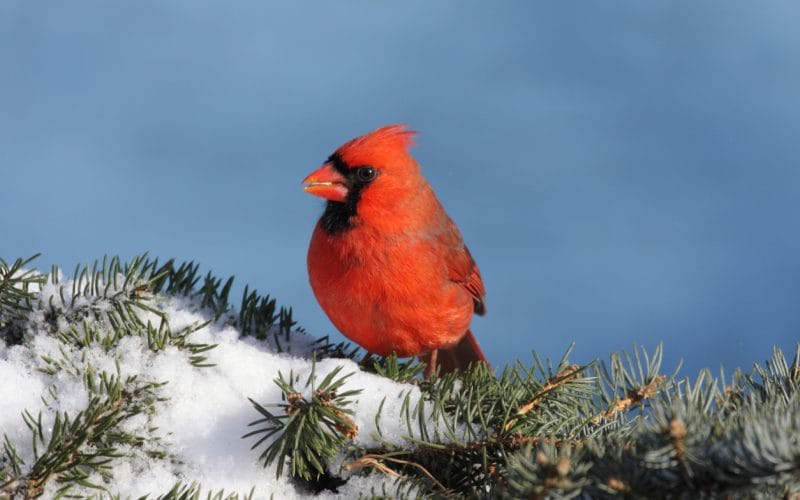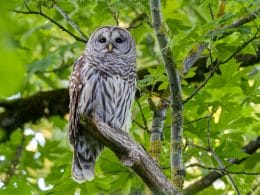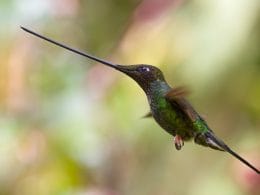Did you know that there are around 41 million birds of different species in the United States? In fact, 246 of those species reside in Minnesota alone. While this might not be considered a high count if you compare it to other states, it’ll still allow you to do some serious birding.
Now, if you’re new to birding and want to know more about the backyard visitors you often see, you’re in the right place!
Let’s take a look at 11 different backyard birds of Minnesota.
Top 11 Most Common Backyard Birds of Minnesota
1. Black-Capped Chickadee
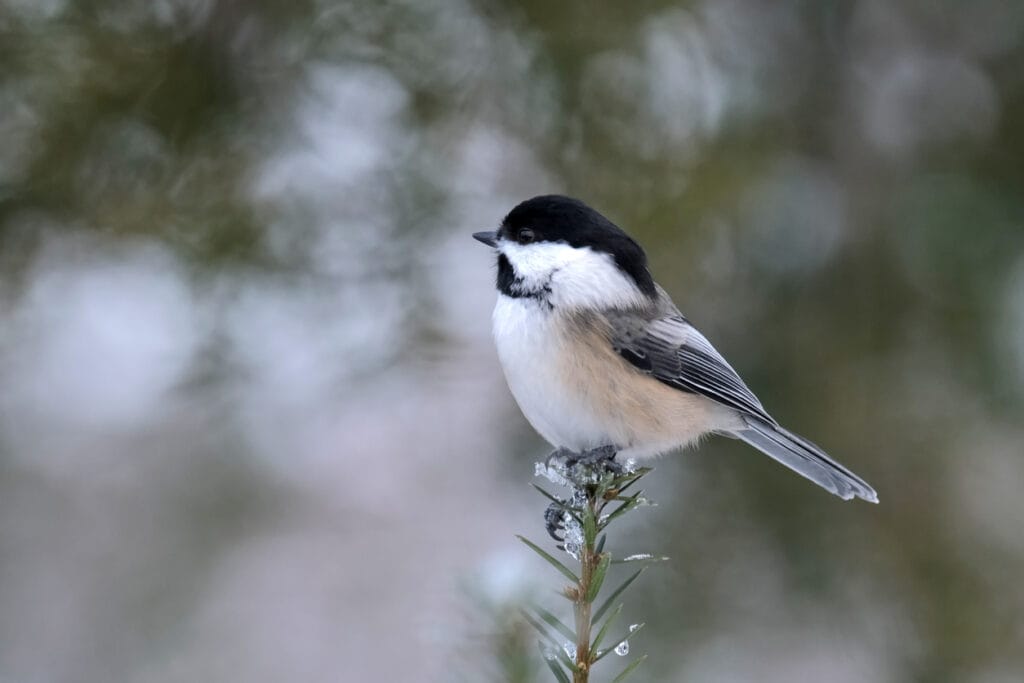
Black-capped Chickadees are passerines, North American songbirds that belong to the family Paridae.
They’re known for their gray backs and wings, white breasts, and white underbellies. They also have medium-sized gray tails with white highlights on the edges. Their faces are white with a large black cap, which stretches from the top of the head to the space under their eyes.
Author Note: Their size varies between 4.6 and 5.9 inches in length and their wingspan can be around 6.2 to 8.3 inches.
Black-capped Chickadees can be found almost anywhere in the forest. However, they’re commonly observed in the branches of birch and alder trees. Another fun fact about these birds is that they like to hide in thickets and shrubberies where they feel safer.
If you find these guys visiting your backyard, you won’t have trouble feeding them things available in your household like peanuts or berries. You can also pick up some oil sunflower seeds for them.
2. Pileated Woodpecker

Native to North America, these birds belong to the Picidae family as well. The Pileated Woodpecker is one of the most common backyard birds of Minnesota.
Pileated Woodpeckers are famous for their white faces that are uniquely marked by a red line stretching from the bill to the cheek. They also have large black wings, black breasts and underbellies, as well as long black tails.
Their color can be quite remarkable in some cases, where they’ll have white patches underneath their wings and on their breasts. It gives them a very unique look in flight.
Pileated Woodpeckers are considered large compared to other Woodpeckers in North America as they’re almost as big as crows. Their size varies between 15.8 to 19.3 inches in length and their wingspan can be measured between 26 to 29.5 inches in flight.
These guys prefer the peace and quiet of heavily wooded parks and mature forests. They commonly nest on dead trees as well. They like to venture into parks and backyards sometimes so you might spot them paying you a visit.
Pileated Woodpeckers love cherries and strawberries as well as nuts and berries. And if you treat them to some suet, they’ll think they’re in bird heaven.
3. White-breasted Nuthatch

White-breasted Nuthatches are songbirds that belong to the Nuthatch family.
As the name suggests, the White-breasted Nuthatches are known for their white breasts and underbellies. They also have gray backs and wings.
White-breasted Nuthatch tails are short with black highlights and white edges. They have white faces and a black cap. One of their distinctive features is a thin black line that stretches from the back of the eyes along their bodies.
White-breasted Nuthatches prefer to nest in mature woods. They’re also known to nest on oak and maple trees, but they venture to parks and backyards occasionally.
Author Note: Their size varies between 5.1 to 5.5 inches in length and their wings have a span of about 7.9 to 10.6 inches.
They eat your usual peanuts, sunflower seeds, and, of course, suet. Yet, these guys love peanut butter. If you treat them to some, you’ll definitely gain a regular visitor to your backyard.
4. Downy Woodpecker
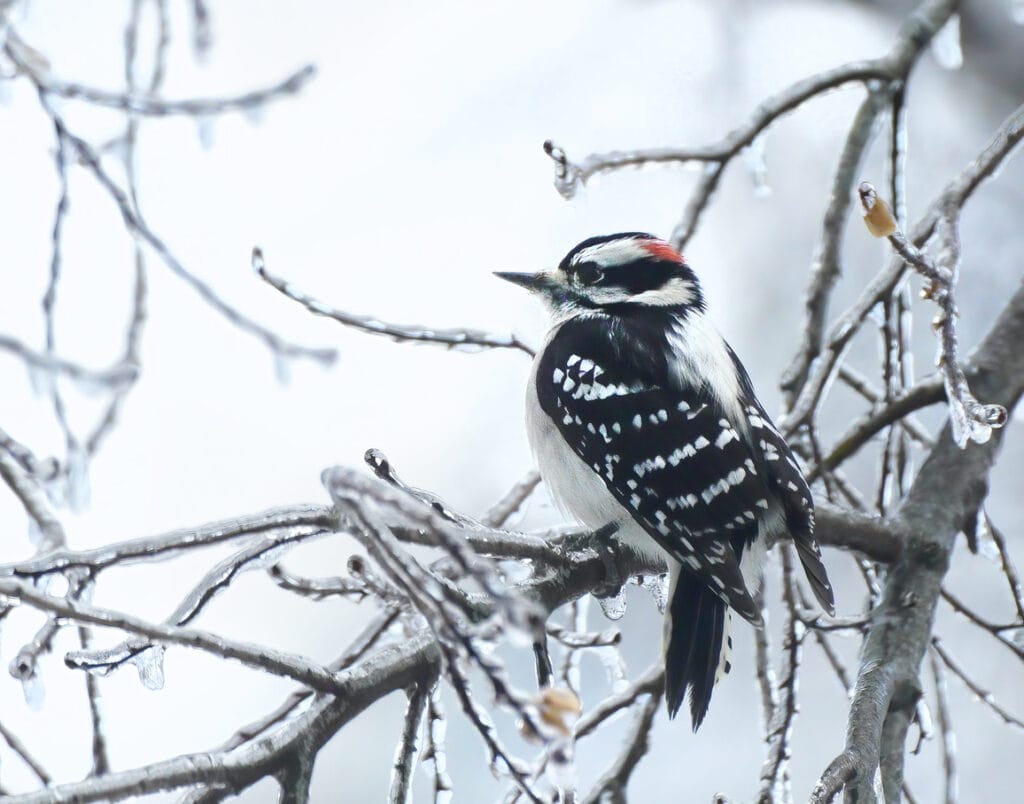
Another really common backyard bird of Minnesota is the Downy Woodpecker. Downy Woodpeckers are widespread in North America. They have white undersides, breasts, and backs. They’re also known for their small, rounded black tails and white-spotted black wings.
An interesting thing about the spotting on their wings is that its shape creates a unique, checkerboard-like pattern.
Downy Woodpeckers’ faces are white with a mustache-like line. They also have a mask that stretches from their eyes to the back of their heads.
Top Tip: The males have a thin black cap that ends at a red spot. However, with the females, the cap remains black. Their beaks are black, straight-shaped, and small.
These guys are fond of heavily wooded areas and open spaces, such as parks or forest edges. They’ll also visit gardens and backyards on occasion.
They’re a bit on the smaller side compared to other woodpeckers. They measure between 5.5 and 6.7 inches in length and their wingspans range between 9.8 to 11.8 inches.
Downy woodpeckers aren’t picky and they like a lot of different foods. They’re known to love peanut butter, suet, and sunflower seeds. They’re especially fond of fruits as well so be sure to leave them a fruity treat in your backyard.
5. Raven
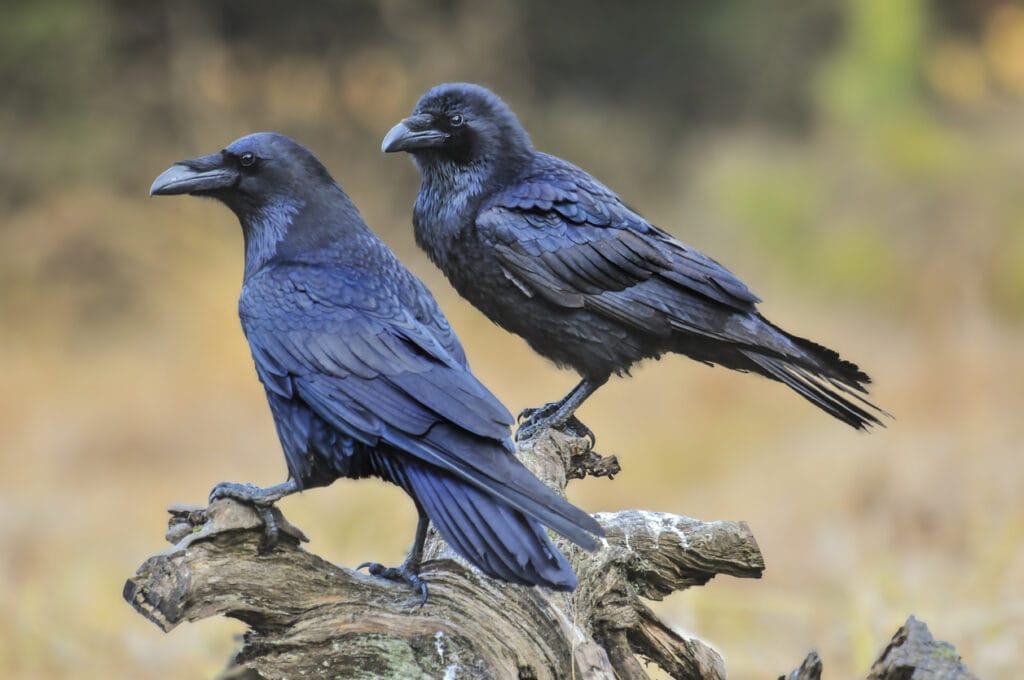
Ravens are passerine birds that belong to the Corvidae family.
We all know what ravens look like, right? You can’t miss them with their glossy black bodies and slightly curved beaks.
These guys vary between 22.1 to 27.2 inches in length and their wingspans range between 45.7 and 46.5 inches.
You can spot ravens almost anywhere, whether it’s deep in the forest or in backyards and parking lots. They’re also commonly spotted in the center areas of Minnesota.
The good thing about ravens is that they’ll eat just about anything, from sunflower seeds, peanut butter, and wheat to whatever leftovers you have available.
If you want to attract them, you can use a homemade prop that has a raven-like shape, like a black painted tin, and place it in your backyard. They’ll think that other ravens visit this area and will want to take a look at the place.
6. Barn Swallow
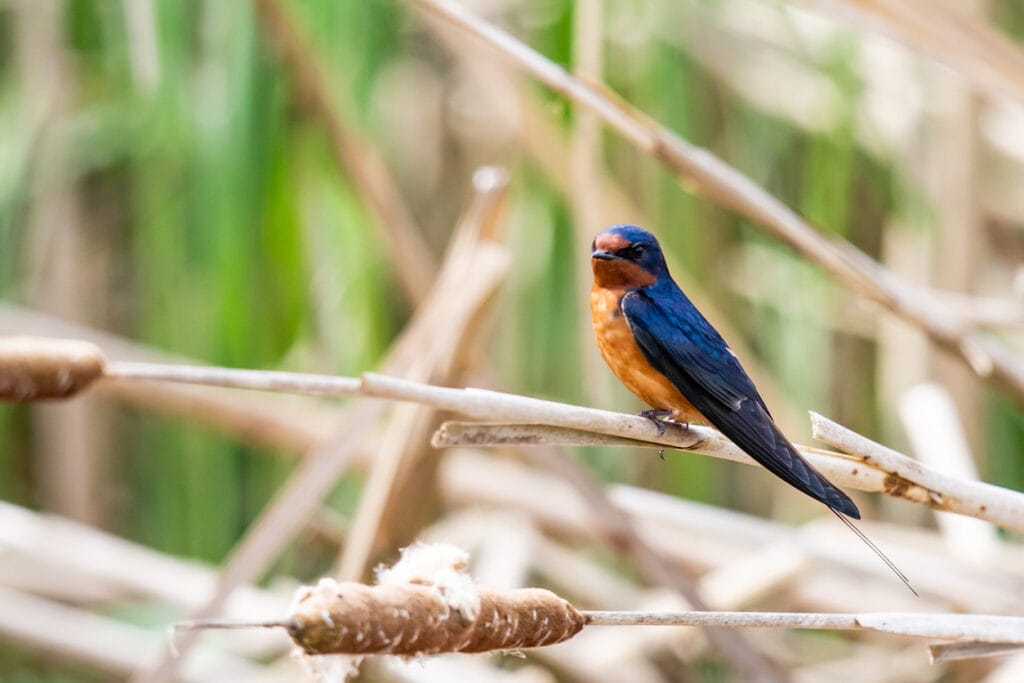
Barn Swallows are considered the most widespread of their species, and they’re best known for their colorful look. Their underbellies and breasts have a mix of a beautiful cinnamon red and a blue shimmer.
The color extends across their bodies and ends with a blue line on each wing.
Barn Swallows have blue wings and backs, and their tails are also blue with some white on the edges. Both males and females share the same features but the color in males is more vibrant than in females.
When it comes to size, Barn Swallows measure between 5.9 and 7.5 inches in length, and their wingspan is between 11.4 to 12.6 inches.
Barn Swallows like to roam around open areas like fields and parks. They love water so you can spot them beside ponds. They have a soft spot for backyard feeders as well, so make sure to leave them a treat!
Barn Swallows mostly eat insects like bees, wasps, and flies. In addition to that, these birds like berries and crushed eggshells. Eggshells are said to help them with digestion.
7. Red-winged Blackbird

Red-winged Blackbirds are passerine birds that belong to the Icteridae family. These guys are all black with red marks on their backs and wings. They can be easy to spot due to the large red and yellow markings on their shoulders and their cone-shaped beaks.
They measure between 6.7 and 9.1 inches in length and have a wingspan of 12.2 to 15.8 inches.
Red-winged Blackbirds are very fond of water. You’ll find them at the edge of ponds or even on wet roads. Your chances are better at getting a visit from them if your backyard is wet after heavy rain.
You only need seeds and grains for these fellas. Mix white proso millet and oil sunflower seeds, put them in your feeder, and you’re most likely to find a visitor soon!
8. Red-eyed Vireo
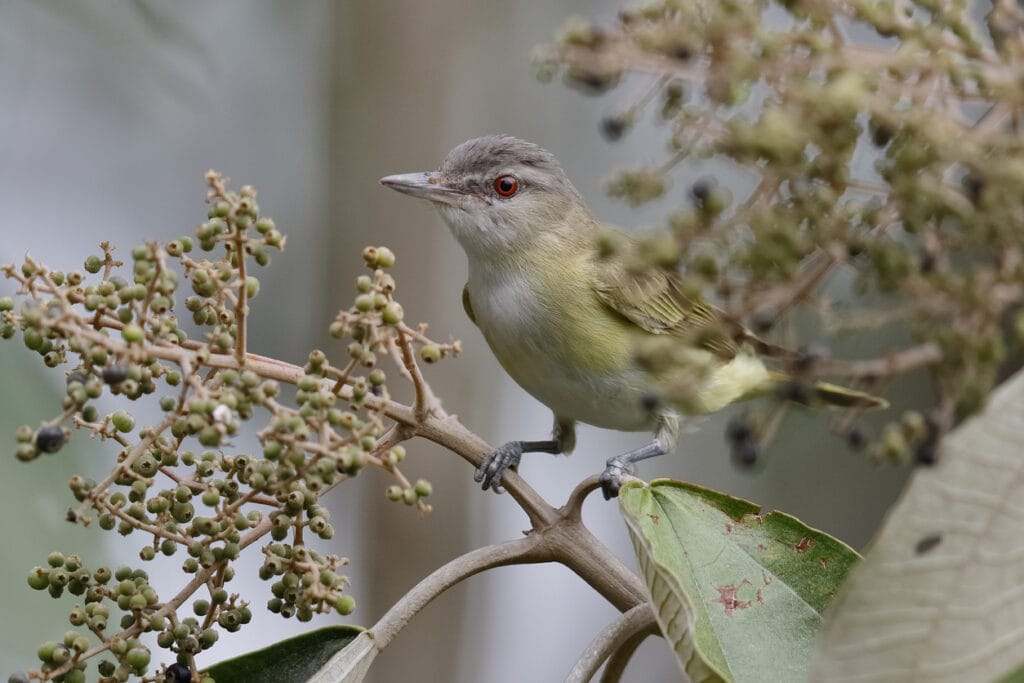
Red-eyed Vireos are American songbirds that are distant cousins to Wood Warblers. They’re known for their yellow-green wings, backs, and tails. Occasionally, you’ll see some gray and black highlights in their wings and tails.
Red-eyed Vireos have white breasts and underbellies. Their faces are an olive-green color with a bit of white under their beaks that stretches to their chins. Their beaks are cone-shaped, medium-sized, and white-colored.
The young birds of this species have dark-colored eyes but the mature ones have red eyes.
They’re very tiny birds and their size varies from 4.7 to 5.1 inches in length. As for their wingspan, it’s around 9.1 to 9.8 inches.
These birds like to wander in mature forests, but they sometimes visit parks and backyards. Their visits are more frequent in winter because they tend to look for shelter and food more actively during this season.
They mostly eat insects but they also like fruits. Cherries, strawberries, and apples are among the ones that grab their attention.
9. Hairy Woodpecker

Hairy Woodpeckers are very widespread in most of North America, and they belong to the Dryobates genus. They’re known to look like a larger version of Downy Woodpeckers.
When it comes to color, these guys have white underbellies and breasts and their faces have a mustache-like line. The mustache line stretches from their beaks to the back of their heads. Quite the gentlemen, no?
Author Note: Their tails have white spots that create a checkered pattern that reaches their wings. Both males and females have the same features and colors, but males are known to have a red mark at the back of the head.
These woodpeckers measure between 7.1 to 10.2 inches in length and their wings have an average span between 12 and 16.1 inches.
Hairy Woodpeckers love older forests and will nest in the dead stubs of living trees. Some of their favorite spots are oak and pine trees. They may be spotted next to felled trees as well because they’re rich in insects.
These birds like to visit parks and backyards, and If you make sure to leave some food for them, they’ll be regular visitors. A little birdy told us that their favorite mix is sunflower seeds and suet.
10. Pine Siskin

Pine Siskins are migratory birds that belong to the Finch family. In terms of color, they have brown wings and backs. There’s also yellow streaking on the wings and tails.
Their faces show heavy streaking and under their beaks is a slightly off-white color surrounded by the pattern on their face. Pine Siskin size ranges between 4 to 5.5 inches in length with a wingspan of 7.1 to 8.7 inches.
Pine Siskins love to wander in open areas and evergreen forests. However, they occasionally venture to gardens and visit backyard feeders as well.
Their favorite treats are white proso millet, sunflower seeds, and Nyjer thistle.
11. American Robin

These birds are migratory songbirds that belong to the Thrush family.
American Robins are known for their grayish-brown wings and gray tails that have white undersides. In some cases, they’ll have white highlights on the edges of the wings.
They’re also known for having a beautiful, shiny orange shade that extends down to their underbelly. Their faces can either be dark gray or black, and their beaks are short with slightly curved bills.
Their size varies between 7.9 and 11 inches in length and they have wingspans ranging from 12.2 to 15.8 inches.
These birds can be spotted pretty much everywhere. They might be in the woods, in your local park, or peeking on your fence and waiting for a treat. American Robins prefer insects and fruits. If you offer either as a nice, quick meal, you’ll have gained a friend for life.
Conclusion
Now that you’ve taken a look at some of the most remarkable backyard birds of Minnesota, you should have a solid idea of what to do to get these guys to visit your backyard.
They may have different looks and sizes, but most of them will be attracted to similar foods like sunflower seeds, suet, nuts, and wheat. We hope you enjoyed this guide on the most common backyard birds of Minnesota.
Sometimes even leftovers can be enough. So, make sure to leave them a treat!
FAQ
t is estimated that there are over 240 species of birds that live in Minnesota. Some of the most common species include the American Robin, the Common Loon, and the Red-tailed Hawk.
One of the largest birds in Minnesota is the Common Loon. Loons can reach a length of up to 30 inches and can weigh up to 8 pounds.
One of the rarest birds in Minnesota is the Harlequin Duck. This species is known for its brightly colored plumage and is considered a threatened species in the state.
In addition to the Common Loon, other large birds found in Minnesota include the Bald Eagle, the Great Blue Heron, and the Sandhill Crane.






